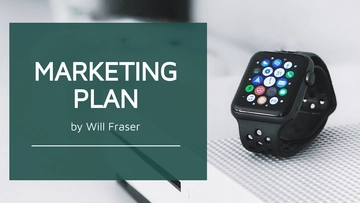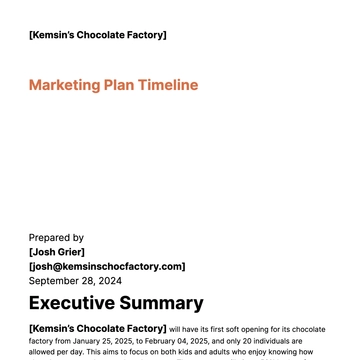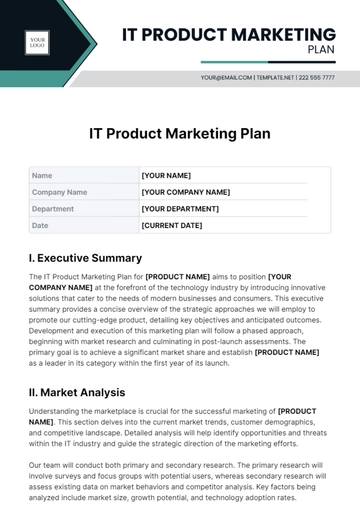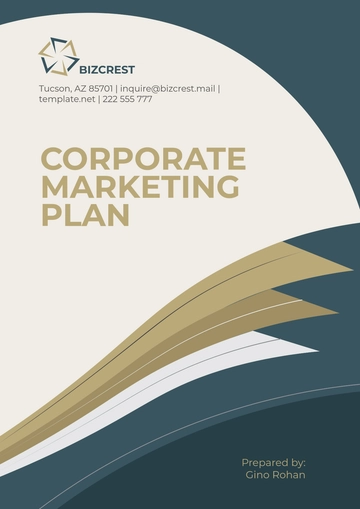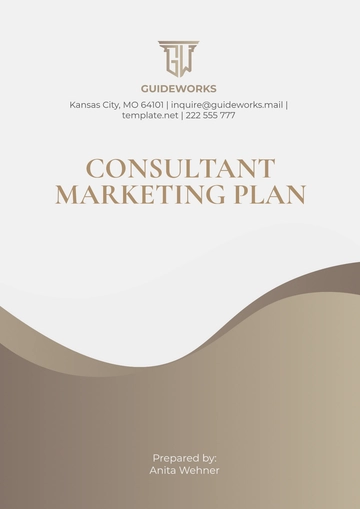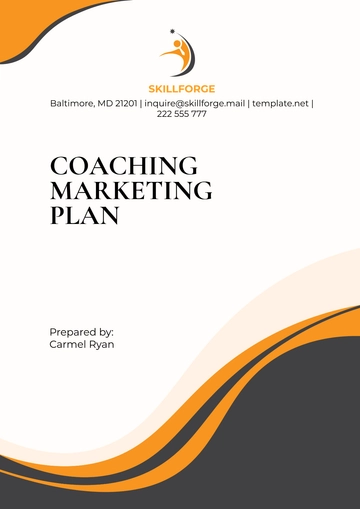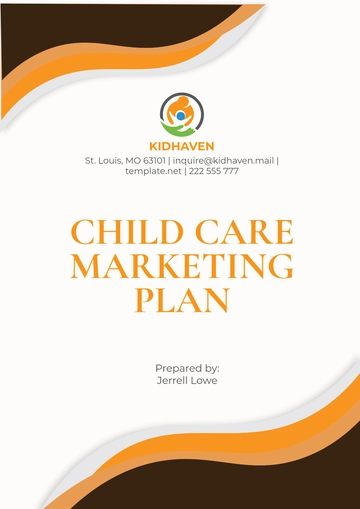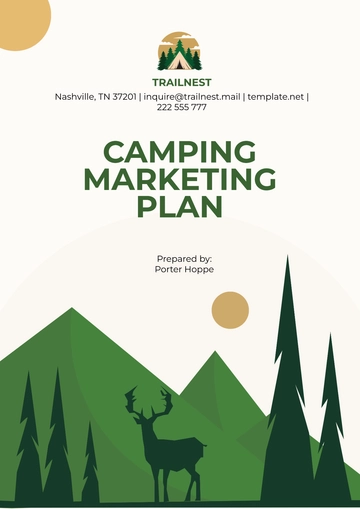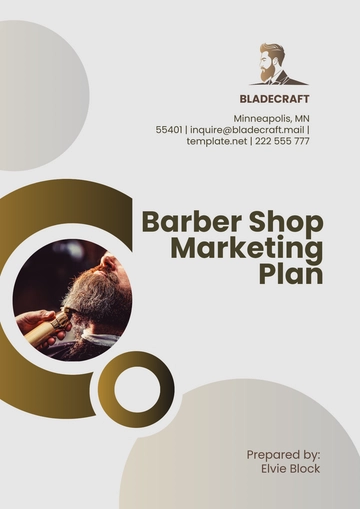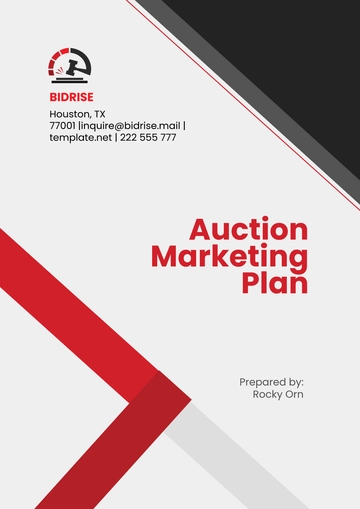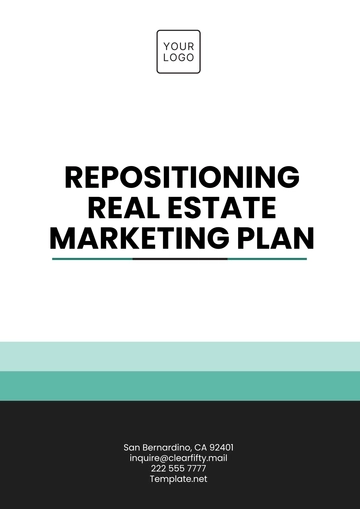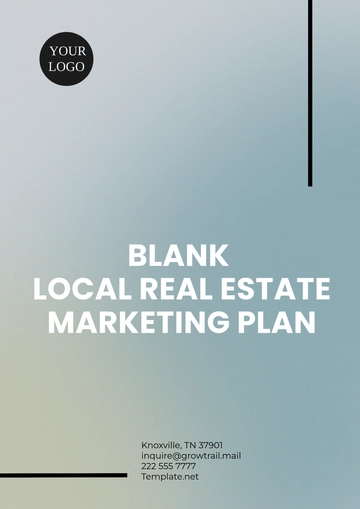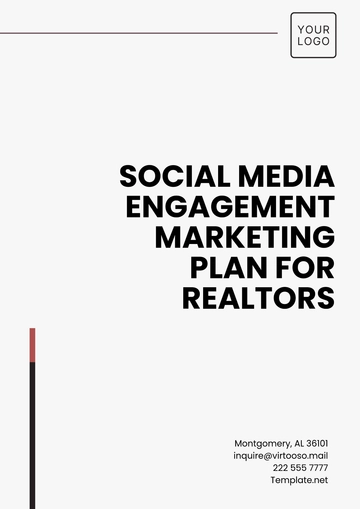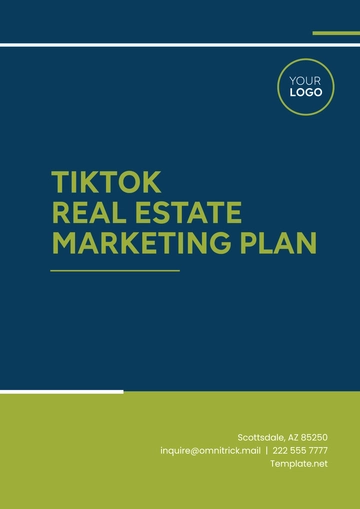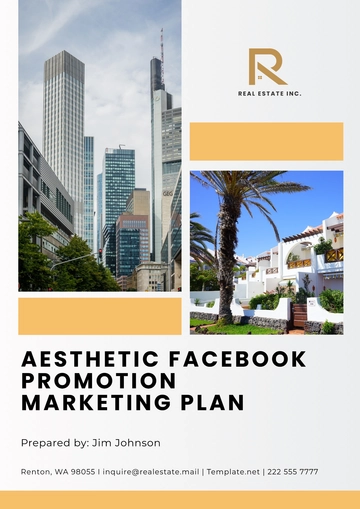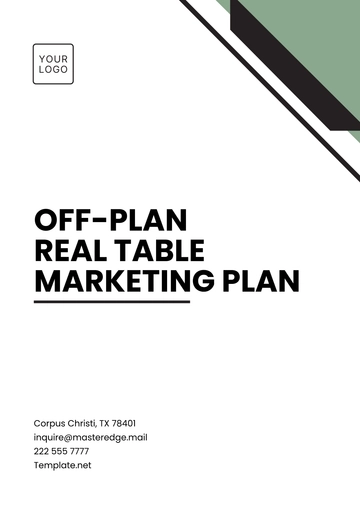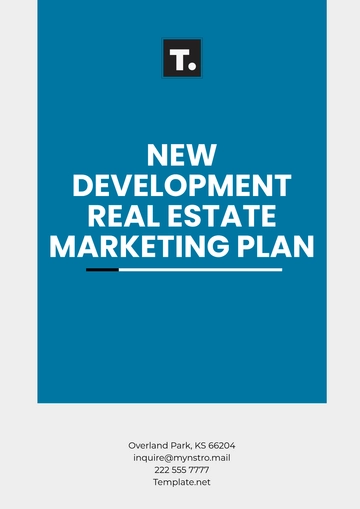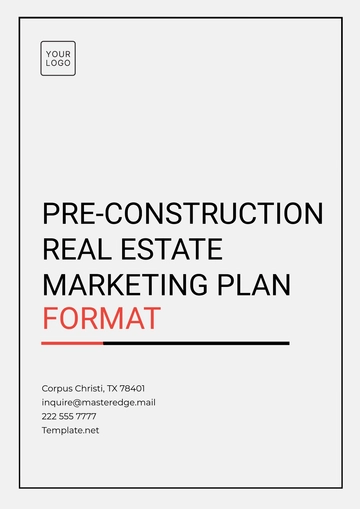Free Retail Marketing Plan
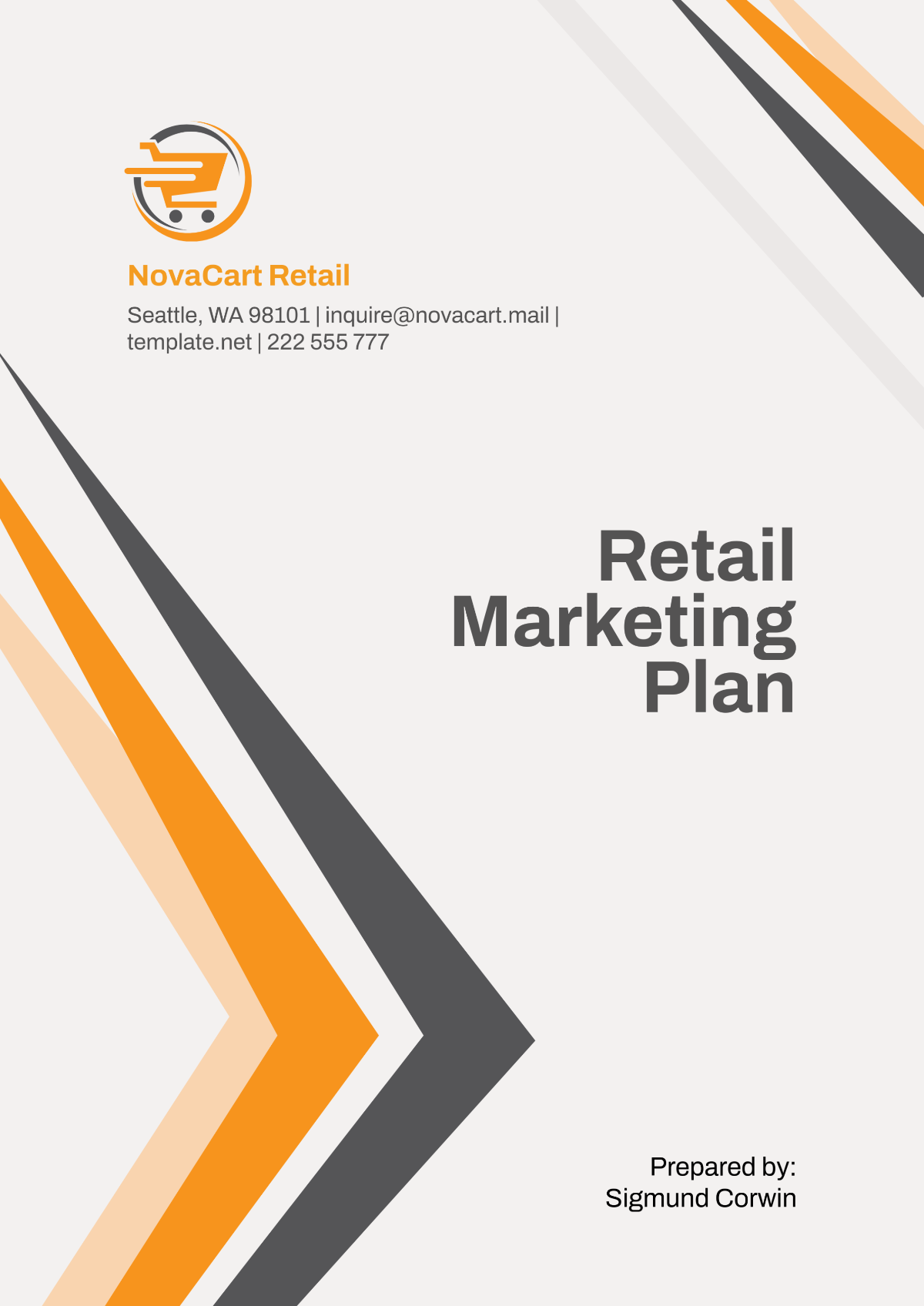
I. Executive Summary
The Retail Marketing Plan for [Your Company Name] has been strategically designed to ensure robust business growth by focusing on key elements such as sustainability, technological adoption, and customer-centric innovation. The plan highlights our commitment to enhancing customer engagement and optimizing sales channels to capture both new and existing customer segments in competitive markets.
In an era where customer loyalty and personalization drive success, [Your Company Name] is poised to leverage data analytics, AI-powered tools, and omnichannel experiences to craft relevant and meaningful interactions at every touchpoint. Our goal is to achieve a revenue increase of [$10 million] by the end of [2051], as we expand our reach both online and offline, develop cutting-edge products, and engage in global expansion efforts. This comprehensive strategy also places a significant emphasis on sustainability initiatives, with a target of converting [50%] of our product lines to eco-friendly options by [2055]. By focusing on these core strategies, we will solidify our leadership in the marketplace and elevate the brand to new heights.
II. Market Analysis
A. Industry Overview
The retail industry is evolving rapidly in [2050], driven by technological innovation and changing consumer behaviors. Global retail sales are projected to grow at an annual rate of [5%] in the coming years, fueled by a dramatic shift toward e-commerce and omnichannel shopping experiences. As the market adapts to this digital revolution, retailers that can integrate physical and digital touchpoints are expected to outperform those that remain siloed in either channel. Digital-first retail strategies, including virtual shopping assistants, AR experiences, and enhanced personalization through AI, are setting the stage for future growth.
In addition, consumers today are highly aware of sustainability and environmental issues, making it crucial for brands to integrate green practices into their operations. A report from [2050] indicates that [65%] of consumers are now actively seeking brands that prioritize eco-friendly production methods, sustainable sourcing, and reduce their carbon footprint. This growing demand for sustainability is reshaping product development, distribution methods, and marketing tactics across the retail landscape.
B. Target Market
Demographic Profile
Age Groups: The primary demographic focus of [Your Company Name] spans Millennials and Gen Z. These two generations make up [65%] of the consumer base in the retail sector, with Millennials driving product purchases related to home, electronics, and fashion, and Gen Z gravitating toward personalized, tech-driven experiences. By understanding their desires for speed, convenience, and value, [Your Company Name] can tailor its offerings accordingly.
Income Brackets: The target consumer base primarily includes middle to upper-middle-class individuals with annual income brackets above [$50,000]. This group is typically tech-savvy, socially responsible, and willing to pay a premium for quality and sustainability. However, by introducing budget-friendly alternatives, we aim to increase penetration among lower-income groups who are starting to embrace the convenience of e-commerce.
Geography: The target markets for expansion include urban cities across North America, Europe, and key emerging markets in Asia such as India, China, and Vietnam. These markets are experiencing increased urbanization and higher disposable income, making them ripe for retail growth.
Psychographic Insights
Consumers today prioritize experiences over products, and personalization has become a key motivator in purchase decisions. Customers expect tailored content, individualized shopping experiences, and products that reflect their personal values. Furthermore, [Your Company Name] will continue to focus on sustainability, transparency, and ethical production to cater to the growing number of conscious consumers.
An overwhelming [80%] of consumers prefer brands that align with their environmental and social values. Therefore, the company’s eco-friendly initiatives and sustainability-focused product lines are pivotal in tapping into this market segment, strengthening brand loyalty, and driving long-term customer retention.
C. Competitor Analysis
Competitor Name | Strengths | Weaknesses | Market Share (%) |
|---|---|---|---|
Competitor A | Well-established reputation, vast product assortment | Slow adoption of digital trends, outdated technology | 25 |
Competitor B | Aggressive pricing, rapid product turnover | Weak emotional connection with customers, lack of sustainability initiatives | 20 |
Competitor C | Strong personalized offerings, focus on luxury | Limited product availability, niche focus | 15 |
Competitor D | Efficient supply chain, eco-friendly offerings | Limited global reach, inconsistent brand messaging | 10 |
By analyzing competitor performance, [Your Company Name] will adapt and innovate where others have gaps. For instance, while Competitor A has a large market share, its slow response to digital innovation presents an opportunity for us to implement cutting-edge e-commerce technologies. Likewise, Competitor B’s lack of focus on sustainability will allow us to differentiate ourselves with our eco-friendly offerings.
D. SWOT Analysis
Strengths | Weaknesses |
|---|---|
Strong brand recognition and reputation for quality | Limited presence in certain global markets, especially in Asia and South America |
Extensive data analytics capabilities for personalized marketing | Over-reliance on seasonal sales cycles, which can affect year-round performance |
Robust online presence and growing social media following | The risk of overexpansion without ensuring quality control and customer service |
Opportunities | Threats |
|---|---|
Expansion into emerging markets (e.g., Vietnam, Brazil) | Economic downturns that may affect discretionary spending |
Growth in demand for sustainability and ethical products | Increasing competition from niche, eco-conscious brands |
Integration of artificial intelligence (AI) for enhanced customer service | Regulatory changes related to data privacy and e-commerce taxes |
III. Marketing Objectives
A. Short-Term Goals ([2050-2051])
E-Commerce Growth: Achieve a [20%] year-over-year increase in online sales by optimizing the user experience, implementing AI-driven recommendations, and offering exclusive online-only promotions.
Sustainability Line Launch: Introduce a new line of eco-friendly products, targeting a [15%] market share within the first year. These products will be sourced from sustainable materials and designed to reduce environmental impact, aligning with our customers' increasing demand for green products.
Loyalty Program Enhancement: Improve customer retention by [15%] through targeted email campaigns, enhanced rewards programs, and personalized offers that resonate with specific customer segments.
B. Long-Term Goals ([2050-2055])
Global Market Expansion: Successfully establish a retail presence in [5] new international markets, with a focus on high-growth regions such as Asia and Africa. We aim for [30%] of our overall sales to come from international markets by [2055].
Sustainability Milestones: Transition [50%] of the product range to sustainable materials, eliminating single-use plastic packaging across all categories by [2055]. We also aim to reduce our carbon footprint by [30%] by integrating renewable energy sources in all operations.
Revenue Target: Increase overall annual revenue to [$100 million] by the end of [2055], driven by a mix of organic growth, new product introductions, and global market penetration.
IV. Marketing Strategy
A. Brand Positioning
Core Value Proposition: [Your Company Name] will position itself as a forward-thinking, sustainable brand that offers high-quality products designed for the modern consumer. Our commitment to sustainability, innovation, and customer-centric experiences will differentiate us in a crowded market.
Tagline: "Empowering Everyday Choices" communicates the core message that our brand is a practical solution for conscious consumers looking to make smarter, environmentally responsible decisions.
B. Product Strategy
Core Product Line Expansion: We will expand our range of products, focusing on high-demand categories such as smart home devices, fashion, and eco-friendly consumer goods. By staying ahead of trends, we can offer our customers the latest and most relevant products.
Sustainability Initiative: The introduction of our eco-friendly line will be supported by marketing campaigns highlighting the environmental benefits of each product. Additionally, we will ensure that the entire lifecycle of these products, from production to packaging, meets the highest sustainability standards.
Customization Options: AI and data analytics will play a central role in personalizing the shopping experience for our customers. Through our online store, customers will be able to customize product designs, sizes, and packaging preferences, providing a tailored experience that meets their individual needs.
C. Pricing Strategy
Competitive Pricing: We will implement a competitive pricing strategy that positions our products as both affordable and high-value. The goal is to offer better quality at similar or lower prices than competitors, driving both customer loyalty and market penetration.
Discounts and Promotions: Seasonal promotions, exclusive discounts for members, and strategic bundling will help drive sales and increase average order value. Regular promotions will be run during peak shopping seasons such as Black Friday, Cyber Monday, and the holiday period.
Subscription Models: Introducing subscription-based services for high-demand products (e.g., skincare, supplements, eco-friendly packaging) will allow us to secure repeat business while offering customers convenience and savings.
D. Distribution Channels
Channel | Contribution to Sales (%) | Expansion Goals [2050-2051] |
|---|---|---|
Online (E-commerce) | 50 | Integrate AI for personalized recommendations and AR shopping |
Physical Retail Stores | 40 | Open 10 new stores globally, with a focus on flagship locations in North America and Asia |
B2B (Partner Platforms) | 10 | Onboard 5 new partners in key markets such as Europe and South America |
V. Promotional Plan
A. Digital Marketing Campaigns
Social Media: Social media marketing will remain a cornerstone of our strategy. We will leverage partnerships with influencers who resonate with our target demographic. Regular content will be posted across platforms, driving engagement and building brand awareness.
Content Marketing: We plan to generate organic traffic through blog posts, educational videos, and guest articles. The goal is to establish [Your Company Name] as a thought leader in the sustainability and consumer goods sectors.
Email Marketing: Monthly newsletters will feature exclusive offers, product updates, and sustainability tips. Additionally, segmented email lists will enable us to target specific customer needs, driving conversions through personalized communications.
B. Offline Campaigns
In-Store Events: Store openings and new product launches will be accompanied by live events such as pop-up stores, workshops, and influencer meet-and-greets. These events will allow customers to engage directly with the brand and create memorable experiences that encourage loyalty.
Community Collaborations: Partnering with local businesses, artists, and communities for experiential marketing campaigns will ensure that [Your Company Name] remains connected to local cultures while expanding our customer base.
Seasonal Sales: Special promotions during holidays will be designed to maximize foot traffic in physical retail stores. Exclusive in-store discounts and bundle offers will be used to drive impulse purchases.
C. Loyalty and Referral Programs
Customer Loyalty Program: We will introduce a point-based rewards system, where customers can earn points for every dollar spent and redeem them for discounts, free products, and exclusive offers. The goal is to build long-term relationships with customers.
Referral Incentives: Customers will be encouraged to refer friends through our referral program, with rewards such as [$20] credits or exclusive early access to sales. This will create a community of brand ambassadors who actively promote our offerings.
VIP Program: VIP members will receive special perks, such as early access to new products, personalized shopping experiences, and priority customer support, making them feel valued and more likely to remain loyal to the brand.
VI. Budget Allocation
A. Overview
The budget allocation for [Your Company Name] in [2050] has been carefully planned to ensure efficient resource use while maximizing return on investment (ROI). The total marketing budget of [$5 million] has been divided across key areas based on their expected impact on business growth. This budget ensures that we are prioritizing initiatives that will support our long-term sustainability goals, global expansion, and customer retention strategies.
B. Detailed Breakdown
Expense Category | Projected Budget ($) | Percentage of Total (%) |
|---|---|---|
Digital Marketing | 2,000,000 | 40 |
Product Development | 1,500,000 | 30 |
Store Expansion | 1,000,000 | 20 |
In-store Campaigns | 500,000 | 10 |
Total | 5,000,000 | 100 |
1. Digital Marketing
With the increasing shift towards online shopping, a large portion of the marketing budget will be directed toward digital marketing efforts. The [$2 million] allocation will focus on the following:
Search Engine Marketing (SEM): [$500,000] will be allocated to paid search ads to drive immediate traffic to the website, especially during key retail periods. This will also include retargeting ads to ensure that potential customers who have shown interest are re-engaged.
Social Media Marketing: [$700,000] will fund advertising campaigns on platforms like Instagram, Facebook, TikTok, and emerging social platforms where our target demographics are most active. These platforms will be key for promoting sustainable product lines and building brand awareness.
Content Creation: [$300,000] will be invested in high-quality video content, blog posts, and interactive campaigns that showcase our sustainability efforts, product benefits, and brand story. We will also integrate AI-driven content personalization to better connect with individual customer preferences.
SEO and Influencer Partnerships: [$500,000] will focus on improving organic search rankings through SEO initiatives. Additionally, we will collaborate with influencers who resonate with our audience to promote brand advocacy and new product launches.
Email Marketing: [$500,000] will support segmentation strategies for personalized email campaigns, targeting specific customer groups with tailored promotions, product recommendations, and loyalty rewards.
2. Product Development
Innovation and product diversification are vital for staying competitive in the retail market. The [$1.5 million] earmarked for product development will support the following:
Eco-Friendly Products: [$800,000] will be used for the research, design, and production of new eco-friendly products. These products will align with our sustainability goals, helping us meet consumer demand for environmentally responsible choices.
Product Testing and Prototyping: [$300,000] will go toward creating prototypes, conducting market research, and receiving consumer feedback to ensure product success before large-scale production.
Technology Integration: [$400,000] will be used for the integration of augmented reality (AR), virtual reality (VR), and artificial intelligence (AI) into the product development process. This may include interactive tools that allow customers to visualize products in their own space or receive personalized recommendations.
3. Store Expansion
The physical retail store plays a critical role in the omnichannel strategy, providing customers with the opportunity to engage with the brand in a tactile way. The [$1 million] allocated for store expansion will be used for:
Opening Flagship Stores: A portion of the budget, [$600,000], will be allocated to the construction, design, and setup of flagship stores in high-priority locations. These stores will focus on providing a premium customer experience and serve as key touchpoints for brand loyalty.
Store Technology: [$250,000] will be used to enhance in-store technologies such as self-checkouts, digital price tags, interactive displays, and AI-powered customer service tools.
Retail Staff Training: [$150,000] will fund training programs to ensure that in-store staff is well-versed in the brand’s sustainability practices, customer service standards, and product knowledge. This will enhance the customer experience and increase conversion rates.
4. In-Store Campaigns
In addition to digital marketing, physical stores play an important role in driving revenue and building brand loyalty. [$500,000] will be allocated to the following in-store promotional activities:
Seasonal Promotions: A portion of this budget will be used for running seasonal campaigns during peak periods, such as Christmas, New Year, and Black Friday. This will include in-store discounts, exclusive product offerings, and attractive store displays.
Pop-Up Events: We will host pop-up events showcasing our sustainable product lines, new launches, or collaborations with other eco-friendly brands. This strategy helps create buzz around the brand and engages customers in an immersive way.
Loyalty Program Integration: The in-store experience will be integrated with our digital loyalty program, allowing customers to earn and redeem points both online and in physical stores, further promoting cross-channel engagement.
VII. Implementation Timeline
A. Overview
The timeline for implementing this retail marketing plan spans from [2050] to [2055], with key milestones and actionable steps mapped out for each quarter of the year. The activities in this section will ensure that the planned marketing strategies are executed efficiently and on time, while tracking progress against pre-defined objectives.
Activity | Start Date | End Date | Responsible Team |
|---|---|---|---|
Launch Sustainability Line | January 2050 | June 2050 | Product Team |
Open New Stores | March 2050 | December 2050 | Retail Expansion |
Digital Campaigns Rollout | February 2050 | Ongoing | Marketing Team |
Loyalty Program Revamp | April 2050 | July 2050 | Customer Success |
Product Development Review | May 2050 | November 2050 | Product Team |
Social Media Influencer Campaign | June 2050 | Ongoing | Marketing Team |
1. Phase 1: Initial Rollouts (Q1-Q2, 2050)
During the first quarter, our focus will be on the launch of new eco-friendly products, ensuring their availability in both online and offline stores. We will roll out our digital marketing campaigns to create awareness, and prepare our sales teams to provide in-store support for customers. Simultaneously, we will begin the initial phases of store expansion in key regions.
2. Phase 2: Expansion and Engagement (Q3-Q4, 2050)
In the second half of the year, we will ramp up our marketing efforts, expanding into new geographic regions. Physical retail stores will begin opening in major metropolitan areas, and pop-up events will be held to showcase the sustainability product line. By the end of [2050], we aim to have achieved an initial revenue increase of [$3 million], driven largely by these expansions and new product offerings.
3. Phase 3: Consolidation and Growth (2025 and Beyond)
Once the foundation is laid in [2050], we will focus on expanding our product offerings, refining our digital and physical strategies, and ensuring that the omnichannel experience is seamless. The goal is to sustain growth through continuous innovation, with a focus on customer satisfaction and loyalty building.
VIII. Monitoring and Evaluation
A. Key Performance Indicators (KPIs)
To evaluate the effectiveness of the marketing strategies and measure their impact on business goals, the following KPIs will be tracked:
Sales Revenue: A target of [$10 million] revenue increase by the end of [2051] will be tracked monthly and quarterly to ensure we are on track to meet growth objectives.
Customer Retention: Our goal is to increase customer retention by [15%] by improving loyalty programs and offering personalized experiences. This will be tracked through CRM and customer feedback surveys.
Conversion Rates: By optimizing our online presence, we aim to increase online conversion rates from [3%] to [5%] by the end of [2051]. Conversion optimization tools such as A/B testing and UX design improvements will be used to monitor progress.
Social Media Engagement: A [20%] increase in social media engagement will be targeted through influencer collaborations, organic content, and paid advertising campaigns. Engagement metrics such as likes, shares, and comments will be tracked.
Customer Satisfaction: Customer satisfaction will be tracked using Net Promoter Scores (NPS), with a target of achieving a score of [8 or higher] by the end of [2050]. Feedback will be gathered from post-purchase surveys and social media polls.
B. Tools and Metrics
To ensure these goals are met, the following tools and metrics will be used:
Google Analytics: This tool will track website traffic, engagement rates, and conversions, providing key insights into how digital marketing efforts are performing.
CRM Software: We will use CRM systems to monitor customer interactions, track loyalty program metrics, and segment customer lists for targeted email campaigns.
Social Media Insights: Tools like Hootsuite and Sprout Social will provide comprehensive analytics on social media performance, enabling us to adjust content strategies and increase engagement.
Customer Feedback: Regular surveys, focus groups, and social listening will help gather customer insights regarding product satisfaction and overall brand experience.
IX. Conclusion
The Retail Marketing Plan for [Your Company Name] is designed to accelerate the company's growth, with a clear focus on sustainability, digital transformation, and a customer-first approach. By executing this plan, we will significantly increase brand awareness, improve customer engagement, and expand our global presence, ensuring long-term success in the retail industry. Our commitment to innovation, coupled with continuous monitoring of performance metrics, will enable [Your Company Name] to remain at the forefront of the market in the coming decades.
- 100% Customizable, free editor
- Access 1 Million+ Templates, photo’s & graphics
- Download or share as a template
- Click and replace photos, graphics, text, backgrounds
- Resize, crop, AI write & more
- Access advanced editor
Create an effective marketing plan for your retail business using the Retail Marketing Plan Template from Template.net. This editable and customizable template lets you outline strategies, goals, and tactics for promoting your retail business. Use the AI Editor Tool to tailor the plan for maximum impact and adjust it as your business evolves.
